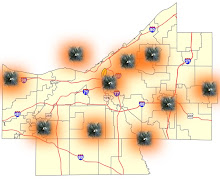Continuing on our discussions about the new I-90 interchange in Avon, Ohio, when is an interchange acceptable to anti-sprawl advocates? Meaning, when shopping centers, big boxes, and malls are the stimulus for an interchange, the investment in infrastructure is frowned upon. However, if the interchange is built to give access to medical campuses, research laboratories, a university campus, or cultural institutions, is the investment then correct?
Sprawl hosts not only strip centers and tacky housing. Sprawl also hosts programs, typologies, architectures, and urbanisms that posses collective value, as suggested above.
Subscribe to:
Post Comments (Atom)





1 comment:
I think you have confused sprawl with growth. Since the region is not growing, I don't see how investment in new infrastructure will improve the situation given the need for significant reinvestment in the region's existing infrastructure. Furthermore, the results of such an interchange, the Targets, the Best Buys and the plethora of other "big boxes", generally do not invest in large "collectively valuable" projects such as "medical campuses, research laboratories, university campuses, and cultural institutions", unless it’s in the city in which their corporate HQs are located. They also do not pay their local employees enough money to be philanthropic, meaning that individuals who would traditionally create foundations or give large amounts of money to civic institutions do not exist. Unfortunately, the future our region does not exist in the cornfields or the outdated theories of decades past. It is time to quit thinking that we can run from our problems are starting pursuing their solutions. So I wish luck to the intrepid pioneers in Avon who wish to put an end to the insanity that is suburban sprawl and hope that in this one instance they succeed where others have failed.
L.S. Moore
Post a Comment